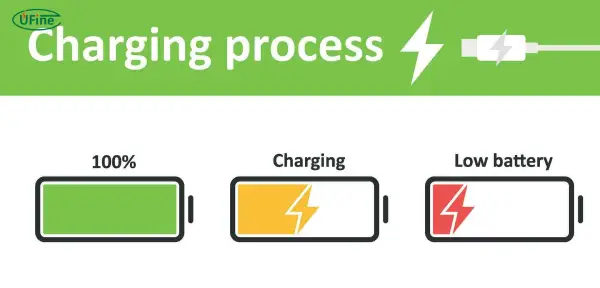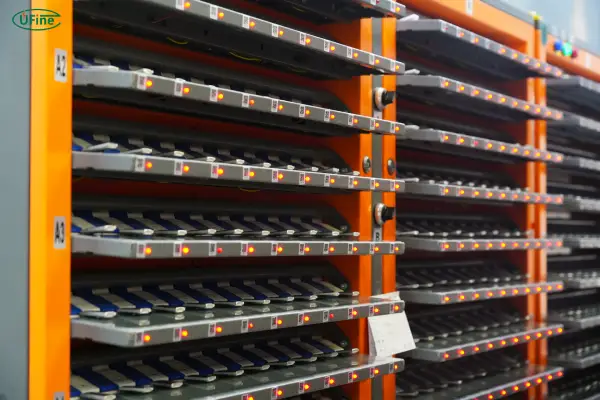
- Part 1. Do lithium batteries need to be fully charged before first use?
- Part 2. Ufine Battery insight: why quality cells matter in charging
- Part 3. What happens if you don’t fully charge a lithium battery the first time?
- Part 4. Factory charging practices: how batteries are pre-charged
- Part 5. First-time charging tips for lithium batteries
- Part 6. Common charging mistakes and how to avoid them
- Part 7. How charging habits affect battery lifespan?
- Part 8. Calibrating lithium batteries: is it still necessary?
- Part 9. Should you charge to 100% daily?
- Part 10. Expert tips for long-term lithium battery care
- Part 11. Final thoughts
- Part 12. FAQs
Part 1. Do lithium batteries need to be fully charged before first use?
The short answer is: No, lithium batteries do not need to be fully charged before first use. Unlike older battery technologies like nickel-cadmium (NiCd) or nickel-metal hydride (NiMH), lithium-ion batteries don’t suffer from memory effect and do not require full charging before they become effective.
That said, the context matters. Some devices may benefit from a full initial charge, not because it’s essential for battery health, but rather to let the battery management system (BMS) calibrate and sync with the software. For most users, though, plugging in your device at 40%, 70%, or even 10% is perfectly fine.
Why Do Some Manufacturers Still Recommend It?
Some manufacturers suggest a full first-time charge as a precautionary measure. It helps in a few ways:
- It ensures the software displays battery levels accurately.
- It guarantees the user gets the maximum battery experience from the start.
- It may help in calibrating the BMS, though modern systems do this over time regardless.
What About the “Battery Calibration” Myth?
This idea dates back to the era of NiCd batteries. Users were told to fully discharge and then fully charge batteries to preserve capacity. However, this practice is not only unnecessary for lithium batteries but can also be harmful. Deep discharges can degrade lithium batteries faster.
Modern BMS chips and software automatically monitor and adjust battery statistics. If calibration is ever needed (which is rare), it’s more about syncing the battery display than preserving actual capacity.
Part 2. Ufine Battery insight: why quality cells matter in charging
Charging safety and efficiency don’t depend only on how you treat your battery. The quality of the battery itself plays a huge role.
Why High-Quality Batteries Are Safer
A well-manufactured lithium battery includes:
- Reliable separators and electrodes that prevent internal short circuits
- Integrated BMS to prevent overcharging, overheating, or over-discharging
- Stable electrolyte materials that reduce the chance of swelling, leaking, or catching fire
Cheaper, poorly made batteries may skip safety layers to cut costs. This puts your devices – and sometimes even your safety – at risk.
Why Choose Ufine Battery
Ufine Battery is a trusted Chinese custom lithium battery manufacturer. We specialize in:
- Lithium polymer batteries
- LiFePO4 batteries
- 18650 and other cylindrical cells
- Ultra-thin, high-rate, and high-temperature lithium batteries
Whether you need batteries for consumer electronics, industrial tools, or electric vehicles, Ufine Battery delivers performance and peace of mind.
Contact Ufine Battery now for custom lithium battery solutions.
Part 3. What happens if you don’t fully charge a lithium battery the first time?
Here’s the good news: almost nothing happens. If you unwrap your device and start using it at 70% or 40%, you’re not doing anything wrong.
Real-World Data Says: No Impact
Multiple studies and testing show that initial charge level has no measurable impact on long-term battery performance. Your battery won’t lose lifespan or degrade faster because you didn’t charge it to 100% first.
Misunderstandings Stem From Older Technologies
Again, the idea of initial full charge dates back to older battery types. Lithium batteries are far more intelligent and stable, thanks to modern charging protocols and BMS support.
Part 4. Factory charging practices: how batteries are pre-charged
Did you know your lithium battery already has a charge when it arrives?
State of Charge (SOC) from the Factory
Most lithium batteries are shipped with a charge level between 30% and 60%. This is considered a safe zone for storage and transport.
Safety and Transport Regulations
Lithium batteries cannot be shipped at full charge. Airline and transport regulations limit the SOC to prevent hazards like overheating or fire during transit.
Typical Pre-Charge in Devices
New phones, laptops, or power tools usually arrive with 40–70% charge – enough to power on and begin use immediately.
Part 5. First-time charging tips for lithium batteries
Want to ensure your battery starts strong? Try these practical tips:
- Use the original charger that came with your device
- Let the battery charge gradually, especially for the first few cycles
- Avoid draining it to 0% before recharging
- Let your battery rest for 10–15 minutes after first use before recharging
Letting the BMS Settle
During the first few charge cycles, the BMS learns your usage pattern. Avoid erratic charging at first. Aim for 20% to 90% range charging for optimal results.
Part 6. Common charging mistakes and how to avoid them
Even great batteries can fail if treated badly. Here are common lithium battery charging mistakes:
Overcharging
- Myth: Overcharging always causes damage
- Reality: Most lithium batteries stop charging automatically when full
- But: Cheap batteries without protection circuits may continue charging and overheat
Using Incompatible Chargers
- Using third-party chargers with incorrect voltage can harm the BMS
- Stick to trusted brands or the charger your device was designed for
Charging in Extreme Temperatures
- Charging below 0°C or above 45°C can damage the battery
- Always charge in cool, well-ventilated spaces
Part 7. How charging habits affect battery lifespan?
Battery degradation happens over time. But you can slow it down with good charging habits.
Partial Charging Is Healthier
- Instead of charging to 100%, aim for 80–90%.
- Try not to let it fall below 20%.
Avoid Full Discharges
- Letting your battery drain to 0% repeatedly causes stress.
- Lithium-ion batteries degrade faster when frequently fully drained.
Topping Off vs. Deep Charging
- Topping off with 10–20% at a time is better than full cycles.
Part 8. Calibrating lithium batteries: is it still necessary?
What Is Calibration?
Battery calibration refers to syncing your device’s software estimate of charge level with the actual battery capacity.
Do You Need to Calibrate?
Usually, no. But you might want to if:
- Battery readings jump suddenly (e.g., 70% to 20%)
- The device shuts down with battery remaining
How to Calibrate (If Needed)
- Charge to 100%
- Use the device until it turns off at low battery
- Fully charge it again without interruption
Do this once every 2–3 months at most, if needed.
Part 9. Should you charge to 100% daily?
Why 80–90% Is the Sweet Spot
Charging to 100% daily adds stress to the battery. Holding lithium cells at full capacity increases internal resistance over time.
When Full Charging Is Okay
- When preparing for travel or extended use
- For devices like power banks or drones that need full range
For everyday use, keep it in the 20–90% range to extend battery life.
Part 10. Expert tips for long-term lithium battery care
Here are pro-level tips to keep your battery going strong for years:
Storage Best Practices
- Store at 40–60% if unused for weeks or months
- Keep in cool, dry environments
Seasonal Charging Tips
- In winter: Warm the battery to room temperature before charging
- In summer: Avoid charging in parked cars or direct sun
Monitor Battery Health
- Use battery health tools or apps (especially for laptops and phones)
- Look for signs like swelling, heat, or fast drain as warning signs
Part 11. Final thoughts
To wrap up: No, you don’t need to fully charge a lithium battery before first use. It won’t hurt, but it’s not necessary. What matters more is long-term charging habits and using quality batteries from trusted sources.
For safe, reliable, and customizable lithium battery solutions, Ufine Battery is here to help. Our products are designed with protection, performance, and longevity in mind.
Part 12. FAQs
Should I charge my battery overnight?
Yes, if your battery has a proper BMS (which most do). It will stop charging when full. But it’s still better to unplug when you can.
Can I use my device while charging?
Yes. Most modern devices are designed to work safely while charging.
Is fast charging bad for lithium batteries?
Not if it’s supported. But frequent fast charging can cause more heat and slightly faster degradation. Use fast charge only when needed.
Related Tags:
More Articles

A Complete Guide to the Best Batteries for Flashlights
Discover the best batteries for flashlights: alkaline, lithium, NiMH & rechargeable options. Tips for performance and maintenance.
Graphene Battery vs Lithium Battery: Which is Better?
Compare graphene battery vs lithium battery in energy density, charging speed, lifespan, cost, and EV applications. Learn which battery leads in 2025.
What is the Difference Between MCA and CCA on Batteries?
Learn the difference between MCA and CCA batteries. Understand what MCA means, what CCA is, and how to choose the right battery for vehicles or marine engines.
Type of Lithium Battery Voltage
Learn lithium ion battery voltage, nominal voltage, and voltage range. Compare Li-ion, LiPo, LiFePO4, and 18650 voltages, charging, and device compatibility.
Gel Battery vs Lead Acid: A Detailed Comparison
Compare gel and lead-acid batteries: lifespan, cost, charging, DoD, safety, and key use cases. Find the right battery for solar, marine, EV, UPS, and daily use.




